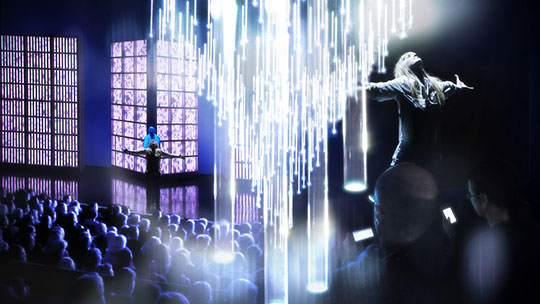Simulcast Production Team
- Executive Producers
- Tod Machover
- Keith Cerny
- Bob Ellis
- MIT Media Lab
- The Dallas Opera
- Producer
- Simone Ovsey
- Director of Production
- John Toia
- Technical Director
- Drew Field
- Remote Broadcast Operations Manager
- Barbara Sipes
- Creative Director, Visual Design and Software Systems
- Peter Torpey
- Sound Designer
- Chris Full
- Sound Technologies and Network Systems
- Ben Bloomberg
- Directorial Consulting
- Diane Paulus
- Andrew Eggert
- Allegra Libonati
- Broadcast Audio
- Charles Holbrow
- Internet Performance System Monitoring
- Brian Mayton
- Mobile Device Infrastructure
- Garrett Parrish
- Networks
- Michail Bletsas
- John Ferguson
- Director of Marketing
- Carrie Ellen Adamian
- Marketing Materials Design
- Victoria Eiker
- Luke McKenzie
- Director of Media and Public Relations
- Suzanne Calvin
- Additional PR Support
- Kirshbaum-Demler & Associates (New York)
For WFAA-TV
- Production Manager
- Jerry Cadigan
- Facilities Manager
- Don Hazen
- VP/Product Development
- Dave Muscari
- Director
- Aaron Butler
- Assistant Director
- Rob Horning
- Director of Community Marketing
- Stephanie Wilcox
- Technical Consultant
- Jeff Stephens
Global Interactive Simulcast
The live global interactive simulcast of the final February 2014 performance of Death and the Powers in Dallas made innovative use of satellite broadcast and Internet technologies to expand the boundaries of second-screen experience and interactivity during a live remote performance. In the opera, Simon Powers uploads his mind, memories, and emotions into The System, represented onstage through reactive robotic, visual, and sonic elements. Remote audiences, via simulcast, were treated as part of The System alongside Powers and the operabots. Audiences had an omniscient view of the action of the opera, as presented through the augmented, multi-camera video and surround sound. Multimedia content delivered to mobile devices, through the Powers Live app, privileged remote audiences with perspectives from within The System. Mobile devices also allowed audiences to influence The System by affecting the illumination of the Winspear Opera House’s Moody Foundation Chandelier.
The interactive simulcast was presented at these locales:
- MIT Media Lab, Cambridge
- Bing Concert Hall, Stanford University
- Hammer Museum, Los Angeles—presented by The Industry
- San Francisco Conservatory, with Opera Parallèle
- Perot Museum of Science and Nature, Dallas
- National Opera Center, New York
- Opera Philadelphia and the Franklin Institute
- Royal Academy of Music, London
- Operahögskolan and KTH, Stockholm

Video Gallery
PBS Newshour features Peter Torpey on Death and the Powers
PBS Newshour features Ben Bloomberg on Death and the Powers
PBS Newshour chief arts correspondent Jeffrey Brown reports on the Death and the Powers
Mobile Experience
Audiences at the remote venues were encouraged to use their mobile devices during the simulcast screening. Using the Powers Live application available for Android and iOS phones and tablets, audience members received a unique second-screen experience. The device acts like a portal to The System, illuminating, vibrating, and producing sounds in sync with the broadcast. It extended the visual language of the show out from the screen and into the audience as if a pixel was placed in each individual's hands, and at times lighting up the simulcast venue. Visuals displayed through the Powers Live app responded in to data from the live orchestra in Dallas and Disembodied Performance data from Robert Orth's portrayal of Simon Powers in The System. The visuals would also react to how each device was held or touched. At key moments, the visual elements prompted audiences to directly interact with their devices to influence the live production in the Winspear Opera House in Dallas.
Torpey, P. and Bloomberg, B. "Powers Live: A Global Interactive Opera Simulcast." Proceedings of ACE. Funchal, 2014.
Moody Foundation Chandelier
For the Dallas performances of Death and the Powers, the Winspear Opera House's iconic Moody Foundation Chandelier became a part of the show in unprecedented ways. The grand, beatiful chandelier is composed of over 300 transparent rods that resemble the structure of Powers's operabots and the positions and color of each can be controlled. The rods can retract into the opera house ceiling, or descend 50 feet to float among the audience.
To integrate the chandelier into Death and the Powers, it was connected to the productions existing technological infrastructure. The chandelier could then visually relate to the walls and lighting onstage and come alive with baritone Robert Orth's performance of Simon in The System through Disembodied Performance. The chandelier also took the form of the Matrix of Light, a visual representation of being inside The System.
The Moody Foundation Chandelier provided a unique opportunity for remote audiences to during the live interactive simulcast to become present in the opera house in Dallas. Using their mobile devices, and particular moments, remote audiences inhabit The System. Their actions and behaviors on their mobile devices were transmitted back to the ongoing production and shaped the illumination of the chandelier. On their mobile devices, audiences would see a visual representation akin to what was being displayed on the chandelier and subtly prompted a particular interaction. As the touches and gestures of audience members around the world became synchronized with each other, the chandelier would then transition from the chaos of many points of light to the pulsing of uniform presence, for example.